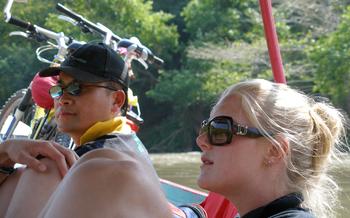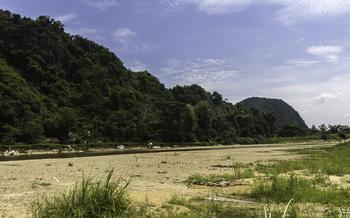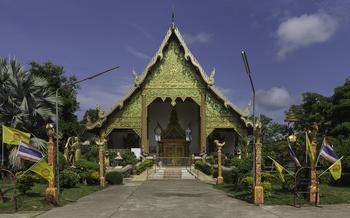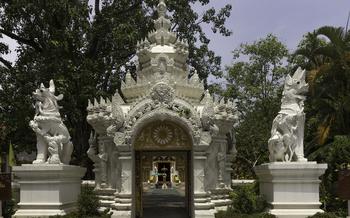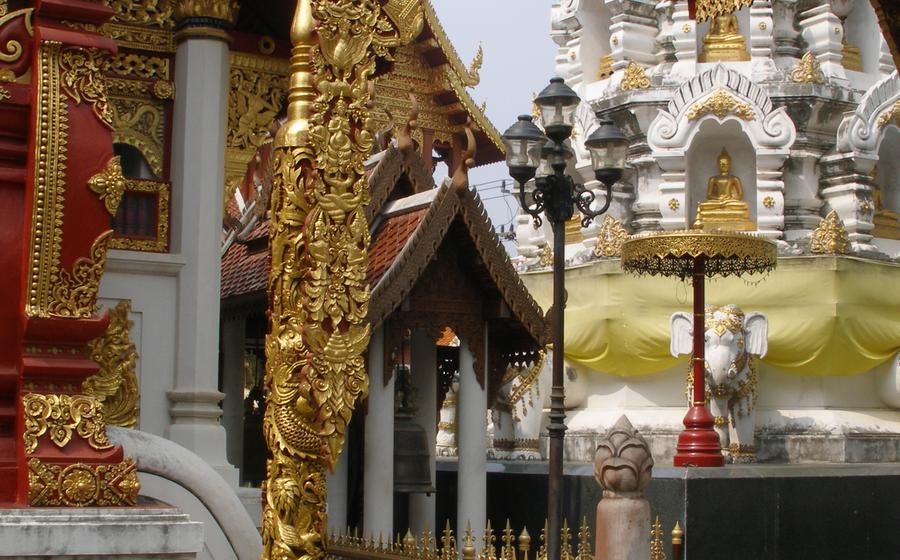
Karen Long Neck Village
- Karen Long Neck Village: A Unique Cultural Experience
- Location and Accessibility
- Village Entrance and Fees
- Interacting with the Karen People
- Observing the Long Neck Tradition
- Cultural Performances and Demonstrations: Showcasing Karen Traditions
- Photography and Respect
- Ethical Considerations and Tourism Impact
- Local Markets and Handicrafts: Supporting Local Artisans
- Trekking and Nature Exploration: Unveiling the Enchanting Landscapes of Chiang Rai
- Homestays and Cultural Immersion
- Language and Communication
- Respecting Village Customs: Honoring Local Traditions
- Responsible Tourism and Sustainability
- Insider Tip: Hidden Gems and Secret Spots
Karen Long Neck Village: A Unique Cultural Experience
The Karen Long Neck Village, nestled in the lush mountains of Chiang Rai, offers a unique glimpse into the fascinating culture of the Karen people. With a history dating back centuries, the Karen have preserved their traditions and way of life, including the practice of elongating their necks with brass rings. This distinctive feature, while visually striking, holds deep cultural significance, representing beauty, femininity, and social status within the community.
The village showcases the Karen's traditional way of life, where simplicity and harmony with nature prevail. Visitors can observe their daily activities, such as farming, weaving, and crafting intricate silver jewelry. The Karen are renowned for their skills in textile weaving, creating vibrant and colorful fabrics that adorn their traditional clothing.
Visiting the Karen Long Neck Village is a profound cultural experience that fosters understanding and appreciation for the diversity of human traditions. It reminds us of the importance of preserving cultural heritage while respecting the rights and dignity of indigenous communities.
Location and Accessibility
The Karen Long Neck Village is situated approximately 80 kilometers northeast of Chiang Rai city, nestled amidst the lush green hills of the Mae Hong Son province. To reach the village, visitors can opt for organized tours departing from Chiang Rai, which typically include transportation, a guided tour, and lunch. These tours offer a convenient and hassle-free option for those seeking a comprehensive experience. Alternatively, adventurous travelers can embark on a self-guided journey, renting a car or motorbike and following the scenic route through the picturesque countryside. The village is accessible year-round, with the best time to visit being during the dry season from November to April when the weather is pleasant, and the roads are in good condition.
Village Entrance and Fees
To enter the Karen Long Neck Village, visitors are required to pay a small entrance fee, which typically includes a guided tour. The fee helps to support the village and its inhabitants, and it is important to pay it respectfully. Local guides play a crucial role in facilitating the visit, providing insights into the village's history, culture, and traditions. They help ensure that visitors have a meaningful and respectful experience. Respectful dressing is essential, and it is advisable to avoid wearing revealing or overly casual clothing. Visitors should also be mindful of their behavior, respecting the privacy and way of life of the villagers.
Interacting with the Karen People
When visiting the Karen Long Neck Village, it's crucial to approach the villagers with respect and cultural sensitivity. The Karen people are welcoming and open to sharing their culture with visitors, but it's important to remember that they are also individuals with their own customs and privacy.
When interacting with the villagers, it's essential to be respectful and courteous. Avoid touching or taking photos of them without their permission, and always ask before entering their homes or private areas. It's also important to be mindful of your tone and language, and to avoid any offensive or insensitive remarks.
Instead of treating the village as a zoo or a show, visitors should approach it as a genuine cultural exchange. Take the time to learn about the Karen people's history, traditions, and beliefs, and engage in meaningful conversations with them. This will help to break down barriers, foster understanding, and create a more enriching experience for both visitors and villagers.
Opportunities for cultural exchange abound within the village. Visitors can participate in traditional ceremonies, learn about Karen cuisine, try their hand at handicrafts, or simply spend time chatting with the villagers and learning about their way of life. By immersing yourself in the Karen culture, you can gain a deeper appreciation for their unique traditions and the challenges they face in the modern world.
Observing the Long Neck Tradition
The Karen Long Neck Village offers a unique opportunity to witness the daily lives of the Karen people and their fascinating customs. Visitors can observe the women going about their daily chores, such as cooking, weaving, and caring for their children, while adorned with their distinctive long necks. The village provides a glimpse into a way of life that has remained largely unchanged for centuries.
The long neck tradition holds deep cultural significance for the Karen people. It is believed that the longer a woman's neck, the more beautiful and desirable she is. The process of creating and maintaining the long necks begins at a young age, when brass coils are placed around the necks of girls as young as five years old. Over time, as the girls grow, additional coils are added, gradually elongating their necks.
While the long neck tradition is a unique and captivating sight, it is important to approach it with respect and understanding. Visitors should refrain from touching or making intrusive comments about the women's necks. Instead, they should focus on observing and appreciating the beauty and resilience of the Karen culture.
Cultural Performances and Demonstrations: Showcasing Karen Traditions
Beyond observing their daily lives, visitors to the Karen Long Neck Village can immerse themselves in the vibrant cultural performances and demonstrations that showcase the unique traditions of the Karen people. These performances often take place in a communal area or a designated performance space within the village. Traditional dances, accompanied by rhythmic music and colorful costumes, bring to life the stories and legends of the Karen culture. Visitors can witness the graceful movements and intricate steps as the dancers narrate tales of love, loss, and community.
In addition to dance performances, visitors may also encounter demonstrations of traditional handicrafts, weaving, and other skills that have been passed down through generations. Skilled artisans showcase their expertise in creating intricate textiles, bamboo crafts, and other handmade items. Visitors can observe the meticulous process of crafting these intricate pieces and gain insights into the symbolism and significance behind each design.
These cultural performances and demonstrations provide an opportunity for visitors to not only witness the beauty and diversity of Karen culture but also to support the local economy. By purchasing handmade souvenirs and handicrafts, visitors directly contribute to the livelihoods of the Karen people and help preserve their traditional skills and cultural heritage.
Photography and Respect
When visiting the Karen Long Neck Village, it's important to be mindful of the ethical implications of photography. While capturing the beauty and uniqueness of the village and its people is natural, it's crucial to do so respectfully.
Before taking any photographs, always ask permission from the villagers. This simple gesture shows respect for their privacy and autonomy. Avoid taking intrusive or disruptive photos that may make them feel uncomfortable. Instead, focus on capturing candid moments that showcase their daily lives and traditions.
Balance your desire for documentation with cultural sensitivity. While it's important to preserve the memory of your visit, it's equally important to respect the boundaries and wishes of the Karen people. By seeking their consent and being mindful of their comfort, you can ensure a positive and meaningful interaction for both parties.
Ethical Considerations and Tourism Impact
Visiting the Karen Long Neck Village presents ethical considerations that require careful reflection. Tourism can have profound impacts on indigenous communities, and it's essential to approach the experience with respect and sensitivity. The Karen people have graciously welcomed visitors into their village, offering a glimpse into their unique culture. However, it's important to remember that they are not merely exhibits for our entertainment. They are real people with their own rights, customs, and traditions.
As visitors, we must be mindful of the potential negative effects of tourism. Our presence can disrupt their daily lives, alter their cultural practices, and even exploit them economically. It's crucial to avoid treating the villagers as commodities or souvenirs. Instead, we should approach them with humility and a genuine desire to learn and understand their way of life.
By respecting their privacy, asking permission before taking photos, and refraining from intrusive behavior, we can minimize our impact and contribute to a positive tourism experience. It's also important to support sustainable tourism practices that directly benefit the village. Choosing tour operators that prioritize responsible tourism and contribute to the community's development is essential.
Ultimately, our goal should be to leave the village better than we found it. By promoting ethical tourism, we can contribute to the preservation of Karen culture while ensuring the community's well-being and dignity.
Local Markets and Handicrafts: Supporting Local Artisans
The Karen Long Neck Village is home to a vibrant local market where visitors can explore a treasure trove of handmade crafts and traditional souvenirs. From intricate textiles and woven fabrics to exquisite jewelry and accessories, each item is a testament to the skill and artistry of the Karen people.
By supporting the local artisans and purchasing their products, visitors not only take home unique mementos but also contribute directly to the preservation of traditional skills and the economic empowerment of the community. Whether it's a hand-woven scarf, a beautifully crafted piece of jewelry, or a decorative artifact, every purchase helps sustain the cultural heritage of the Karen people.
In addition to the market within the village, visitors can explore nearby markets in the surrounding area, offering a wider selection of handmade goods. These markets showcase a diverse range of products, including pottery, bamboo handicrafts, and traditional clothing, providing an opportunity to discover the region's rich cultural heritage.
Shopping at the local markets is not just a transaction; it's an opportunity to connect with the Karen people, learn about their traditions, and appreciate their creativity and craftsmanship. Visitors are encouraged to engage with the artisans, ask questions about their techniques, and support their livelihoods by purchasing their unique creations.
Trekking and Nature Exploration: Unveiling the Enchanting Landscapes of Chiang Rai
Beyond the cultural immersion offered by the Karen Long Neck Village, visitors can embark on invigorating trekking expeditions into the surrounding mountains and forests. These treks provide an opportunity to delve deeper into the region's natural splendor and encounter its diverse flora and fauna.
The village is nestled amidst picturesque landscapes, with rolling hills, lush vegetation, and cascading waterfalls. Trekkers can choose from a range of trails, each offering unique challenges and rewards. Whether you prefer leisurely walks or more strenuous hikes, there's a trail to suit every level of fitness and experience.
Along the way, trekkers can immerse themselves in the region's rich biodiversity. The forests are home to a variety of wildlife, including colorful birds, exotic butterflies, and elusive monkeys. With a keen eye and a little luck, visitors might even spot some of the larger mammals that inhabit the area, such as elephants or wild boars.
For those seeking a truly immersive experience, overnight treks are also available. These treks allow visitors to camp under the stars, surrounded by the sounds of the jungle. It's an unforgettable opportunity to connect with nature and gain a deeper appreciation for the region's unspoiled beauty.
By combining cultural immersion with outdoor adventures, visitors to the Karen Long Neck Village can create a truly unique and memorable travel experience.
Homestays and Cultural Immersion
For a truly immersive experience, consider staying overnight in the Karen Long Neck Village. Homestays offer a unique opportunity to connect with the villagers on a deeper level. You'll share meals, participate in daily activities, and gain insights into their way of life. This is a chance to learn about their traditions, beliefs, and challenges firsthand. Homestays also support the local economy and provide a sustainable source of income for the community. Embrace this opportunity to immerse yourself in Karen culture and create lasting memories.
Language and Communication
To fully immerse yourself in the Karen culture, it's helpful to know a few basic phrases and greetings in their language. While most villagers speak some English, learning a few Karen words can show respect and facilitate communication. Local guides often serve as interpreters, bridging the language gap and providing insights into the cultural nuances. Don't be afraid to ask questions and engage in conversations with the villagers, as they are generally friendly and eager to share their stories. Overcoming language barriers can lead to meaningful connections and a deeper understanding of their way of life.
Respecting Village Customs: Honoring Local Traditions
When visiting the Karen Long Neck Village, it is essential to be mindful of and respectful of local customs and traditions. These customs are deeply ingrained in the Karen culture and help preserve their unique way of life. Here are some essential guidelines to follow:
-
Removing Shoes: Before entering a Karen home, it is customary to remove your shoes as a sign of respect. This is done to keep the house clean and prevent dirt from being tracked inside.
-
Asking Permission: Always ask permission before taking photographs or entering private areas of the village. This shows respect for the villagers' privacy and helps avoid any misunderstandings.
-
Avoiding Intrusive Behavior: Refrain from touching or grabbing the villagers, especially their long necks. This can be seen as disrespectful and intrusive. Instead, ask permission if you wish to take their photograph or interact with them.
-
Respecting Village Life: Be mindful of the daily activities of the villagers and avoid disrupting their way of life. Do not enter their homes or workplaces without permission, and be respectful of their privacy.
By following these guidelines and showing respect for the Karen culture, you can help ensure that your visit is both enjoyable and respectful, contributing to the preservation of this unique community.
Responsible Tourism and Sustainability
When visiting the Karen Long Neck Village, it's essential to practice responsible tourism to minimize negative impacts and ensure the community's long-term sustainability. Choose tour operators committed to ethical practices, such as small group sizes, fair compensation to villagers, and support for community projects. Respect the environment by reducing plastic waste, avoiding littering, and respecting wildlife. Contribute to the village's economy by purchasing handmade souvenirs directly from the artisans and supporting local businesses. By embracing responsible tourism, you can help preserve the Karen culture and ensure that future generations can continue to benefit from this unique experience.
Insider Tip: Hidden Gems and Secret Spots
Beyond the main tourist areas of the Karen Long Neck Village, there are hidden gems and secret spots that offer unique experiences for those willing to explore. One such spot is a secluded waterfall nestled deep within the surrounding jungle. Ask your local guide to lead you to this hidden oasis, where you can enjoy a refreshing dip in the crystal-clear waters and soak in the tranquil ambiance.
Another hidden gem is a viewpoint that offers panoramic vistas of the village and the surrounding countryside. From this vantage point, you can witness the breathtaking beauty of the region and capture stunning photographs of the village nestled amidst the lush greenery.
If you're lucky, you may also have the opportunity to witness traditional ceremonies or festivals that are not open to the general public. These events provide a rare glimpse into the rich cultural heritage of the Karen people and offer a chance to experience their customs and traditions firsthand.
Remember to approach these hidden gems with respect and cultural sensitivity, ensuring that your presence does not disrupt the daily lives of the villagers. Seek permission before entering private areas or taking photographs, and always prioritize the well-being and privacy of the Karen people.

